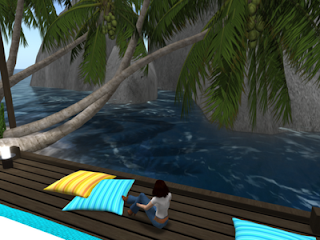Highlighted today is a video, the first in a series of visits to virtual worlds.
The region being visited Terra Virtua in Kitely. Kitely describes itself as "Virtual Worlds on Demand" and states "Each account includes one FREE virtual world." If you sign up at Kitely, you can either use their plugin (the Imprudence viewer) to access your world or launch the viewer of your choice independently of the website. Kitely is based on OpenSim and they state in the FAQ that they
In "Virtual World Tours: Kitely" below, I'm offering basic terms used in virtual worlds and attempting to show what they mean. There are sections showing building, primitive shapes and terraforming. I particularly wanted to show how avatars interact with the 3D environment. Note that avatar Jamie walks into a structure and moves around in it. If there were scripts in place, she could sit on the furniture and interact more fully with things. This video is also available on YouTube in a larger format.
Whew! Three working copies and a total restart later, the video is done.
-- Marge
The region being visited Terra Virtua in Kitely. Kitely describes itself as "Virtual Worlds on Demand" and states "Each account includes one FREE virtual world." If you sign up at Kitely, you can either use their plugin (the Imprudence viewer) to access your world or launch the viewer of your choice independently of the website. Kitely is based on OpenSim and they state in the FAQ that they
use a combination of standard OpenSim running in a ROBUST configuration, with our own proprietary OpenSim modules and web services.Because the worlds are generated on demand, the user must wait for the world to be up and running. This includes teleporting, which can cause awkward pauses, especially if your destination has particularly complex builds or many objects.
In "Virtual World Tours: Kitely" below, I'm offering basic terms used in virtual worlds and attempting to show what they mean. There are sections showing building, primitive shapes and terraforming. I particularly wanted to show how avatars interact with the 3D environment. Note that avatar Jamie walks into a structure and moves around in it. If there were scripts in place, she could sit on the furniture and interact more fully with things. This video is also available on YouTube in a larger format.
***
***
-- Marge









